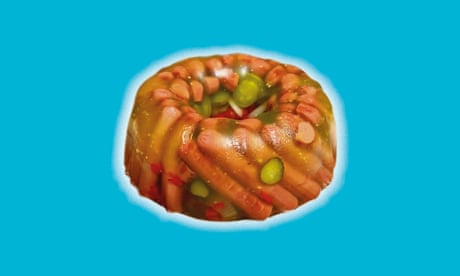- by foxnews
- 24 Nov 2024
The disgusting food of TikTok: is it designed to eat, provoke - or arouse?
The disgusting food of TikTok: is it designed to eat, provoke - or arouse?
- by theguardian
- 19 Apr 2023
- in technology

I have just ironed my husband a toasted sandwich like some kind of tradwife and to be honest, I'm disappointed with his reaction. Admittedly, there were a few issues. The steam didn't help, plus I wrapped it in too much tinfoil, so the heat couldn't penetrate. The main problem, though, was that holding an iron meant I automatically started ironing the package, pressing hard and going to and fro industriously. The result is flat, very flat. "We have a sandwich toaster," my husband points out, holding the crepe-thin delicacy between finger and thumb. He should be thrilled: this is the closest I've come to cooking for him in months. He tries it, reluctantly. "It's very soft. Did you put mustard in it?"
"I thought it would help," I say.
"It doesn't."
Unless you are a particularly online person, you are probably asking why, at this point. It's a question I have asked myself repeatedly, in a rising pitch of incredulity and distress as I dived deep into TikTok food - or FoodTok, if you will. Because that is where the ironed toastie comes from: it's part of a new generation of TikTok recipe hacks that embody a provocative, frankly deranged "why not?" philosophy. We've come a long, wrong way since 2021's viral feta pasta. Now, in addition to ironed toasties, you can enjoy a beatifically smiling blonde putting dried pasta in a blender to create an approximation of flour, then adding an egg to create a sort of dough. She then fashions lumpy, fat noodles, which she boils, tops with tomato sauce and declares "exactly like fresh pasta". Comments include the likes of "YOU VIOLATED THE PASTA", "Ma'am, blink twice if someone is holding you hostage" and many irate Italians.
At the risk of sounding like Grampa Simpson yelling at clouds - which is exactly how I feel exploring FoodTok - what is going on? "There's a long and storied history of gross-out food on social media," says Chris Stokel-Walker, social media expert and the author of TikTok Boom. Twisted, the social media food brand that just announced a collaboration with Iceland, started out in 2016 and dared us to make the likes of deep-fried barbecue chicken-stuffed pizzadilla. Now, says Stokel-Walker, "It's been supercharged by the arrival of TikTok." The app is designed and engineered to "capture people's attention as they are scrolling through that endless feed of content" and one good way to do it is precisely "the outlandish, the gross-out". It is a notion echoed by Jonah Berger, professor at the Wharton school in Pennsylvania and bestselling author of Contagious, a study of social transmission and virality, who notes that these videos combine surprise and often disgust. "The more surprising something is, the more likely we are to share it with others. And disgust is a high arousal emotion that also causes us to pass things on."
So is this content engineered to provoke? Some of it, definitely. "I never work to appear genuine," says Eli Betchik of @elis_kitchen, the self-proclaimed "most evil chef on TikTok". "If anyone asks, I say: 'Yeah, I do this for attention.' I think it's pretty obvious I do." It is a mark of Betchik's evil genius that every video of theirs makes me shout "No!" in genuine anger at some point. Betchik was behind the much-reviled potato crisp mash, and a horrifying sandwich made of blended peas, pineapple, cheese and nuts, with the bread coated with mayo, then fried, among other outrages.
Betchik is a fine art jeweller, who started their channel after discovering TikTok at jewellery school. "I thought, I already love experimenting with food and trying new things - I could probably take that a few steps further and use it for some good old-fashioned shock-value entertainment." Their first video was fried mayonnaise. I make a strangled noise hearing this. "Yeah, it was horrible," confirms Betchik. Another early favourite was meatballs boiled in lime juice "until the juice was a thick syrup. I'm salivating because I can still taste the sourness. It was the most violent flavour I've ever had."
Outrage is the point, and, Betchik says, people enjoy feeling it. "Obviously, what I'm doing is to gross people out, but people keep coming back - they wouldn't keep coming back if they didn't get something out of it. I find that sometimes people get happy when they're upset in the right way." On their jewellery TikTok account @eli_metal, Betchik says, a mean comment would take days to digest, but with the food, it's a mark of success. The one comment they won't accept is that these horrendous creations are wasteful: impressively, worryingly omnivorous, Betchik finishes almost everything. In addition, "I try to use foods that are close to going bad or things that have been donated to me. And if I can't eat it, I compost all the scraps." It's not clear if this level of diligence is common practice among the creators, but it feels doubtful.
Mean commenters on the @myjanebrain TikTok account include a certain Gordon Ramsay, who angrily described a chicken stuffed in a pumpkin, garnished with cinnamon sticks and many onions as "Halloween salmonella right there." "It was pretty awesome," says Jane, a preternaturally cheery 27-year-old Canadian and full-time content creator who prefers not to give her surname, perhaps for fear of reprisals from Italians angered by her ramen "pizza". "But I know the chicken was fully cooked. It was moist, it had great flavour."
Jane ended up in the realm of what is sometimes called "rage-bait" cooking accidentally. Her early videos, she says, were straight instructional content, but she pivoted when her fried chicken recipe went viral. "It got 31m views, 3,000 comments," says Jane - this is, of course, highly populated TikTok territory, the hashtag #FoodTikTok had accumulated 112bn views by the end of 2022, for example. "I thought it would be positive but it was more like: 'You're the worst chef I've ever seen.' So I realised that I would have no idea what people were going to think of my videos."
She started focusing on finding the "craziest combinations", including one titled "I learned this hotdog trick in England", in which she makes jelly from pickle juice, adds frankfurters and eats it in a bread bun. "That is absolutely not English," I challenge her hotly, TikTok commenter style. "I can't remember; it was from some sort of British something," she says. "I was going to ask you why you make pickle juice jelly!" What makes people angriest, though, she says, is her cooking techniques. "As soon as you cook for the internet you open yourself up to all the critics who are so specific in the way they cook."
Both Jane and Eli are clear that their content is knowingly provocative rather than instructional, whether viewers understand that or not. "A lot of people take this content at face value when you have to remember we're through the looking-glass on social media, where these things are being deliberately gamed for the benefit of those that create it," says Stokel-Walker. All attention is good attention, since views and shares - including the genre of angry or incredulous "duet" videos where other creators (including Ramsay) comment on their depravity - are the point. That's how you make money after all: successful TikTokers can become part of the app's creator fund and get paid - admittedly pennies - per view. Stokel-Walker says that success can allow creators to pivot to the kind of genuinely lucrative mainstream collaborations that Twisted has managed.
There is another possibly upsetting angle: fetish. "Videos where they point a lot and touch things and make super-repulsive stuff are apparently fetish," a baker friend tells me airily, when I inquire if she uses TikTok recipes. It turns out there's a fairly widespread suspicion this is a thing. The messier foods could fulfil a "sploshing" fetish: getting sexual gratification from food mess. "I've seen this aired," says Stokel-Walker. "Certainly, it appeals to your senses. It's like a slow-motion car crash in food form, where you're like, how more disgusting can this get?" TikTok user @lenarae.lh analyses food videos and pronounces them fetish or non-fetish on the basis of how the women - it is almost always women - use their hands, splash or squirt stuff suggestively or massage phallic things. A friend also directs me to the work of a creator called @cedriklorenzen who specialises in whacking pieces of raw meat, dribbling, drizzling and taking his top off. It's a better appetite suppressant than Ozempic: after watching, I never want to eat, have sex, or indeed see anything again.
There is actually plenty of good, normal food on TikTok. Asking around, people mention recipes for homemade crispy chilli sauce, broccoli pasta, sesame dip and various noodle dishes they've tried, then added to their repertoire. Seema Pankhania, a 25-year-old former chef de partie at Gordon Ramsay's Lucky Cat who posts as @seemagetsbaked, has 1.3 million followers for her eminently achievable, delicious-looking recipes. They are pleasingly lo-fi, especially her pyjama recipes for hungover, no bones days and ultra simple versions of Indian classics - her butter chicken has 1.7m likes (she also recommends her "super simple creamy chicken curry". But even Pankhania, a proper cook, is aware it is all grist to the gnat's attention span TikTok mill. She aims to keep videos under a minute long ("the shorter the better; people are going to get bored") and has no illusions that much of the food content is only meant to be consumed with the eyes. "There's a whole other field of cooking on TikTok which is indulgent," she says, giving the example of elaborate lasagnes. "Nobody is going to make it, but it's very nice and satisfying to watch." Clearly that goes for the bizarre and the gross-out stuff too in some more depraved way. "At the end of the day, social media is entertainment, right?" says Pankhania. "Most of it is just for entertainment and people aren't actually going to be cooking a lot of it."
Given much of food TikTok isn't meant to be cooked, or is intentionally tongue in cheek, I'm sure I'm missing the point entirely as I cram half a packet of spaghetti into my blender. A flimsy thing, it protests loudly with an ominous smell of burning rubber. I whiz up vermicelli instead, dump the "flour" on the worktop and add an egg, making a claggy mess. I have to add normal flour - surely invalidating the whole madness - to form a dough ball capable of being rolled out. The resultant approximate noodles are dumped in boiling water. I take them out based on vibes alone - TikTok recipes are wildly unspecific - then my family gather to taste and criticise. My husband - whose former student staple of peas and camembert prepared in a kettle would be a runaway TikTok hit - declares it raw. "It's not terrible," one son ventures. "It's not good either," says the other, correctly.
I dare not attempt anything of Betchik's, and Jane recommends her own recipe for cinnamon buns baked in cream and coffee, topped with sugar, butter and flattened toffees - but I am 48 and my organs will explode if I eat that. My wimp's version - a vegan bun sliced and covered in oat cream, sugar and cinnamon - comes out of the oven ominously black; my just deserts for messing with the recipe, I suppose. I eat it all anyway - it's a cinnamon bun and cream, what's not to like? - then, exhausted and hyperglycaemic, I close TikTok, hopefully for good. Everybody's so creative! I wish they weren't.
- by foxnews
- descember 09, 2016
Italy expected to draw travelers by the millions as Pope Francis kicks off Holy Year
The 2025 Jubilee will bring tourists to the Vatican, Rome and Italy to celebrate the Catholic tradition of patrons asking for forgiveness of sins. Hope will be a central theme.
read more





